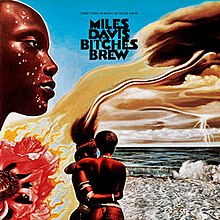
Miles Dewey Davis III was an American jazz trumpeter, bandleader, and composer. He is among the most influential and acclaimed figures in the history of jazz and 20th-century music. Davis adopted a variety of musical directions in a roughly five-decade career that kept him at the forefront of many major stylistic developments in jazz.
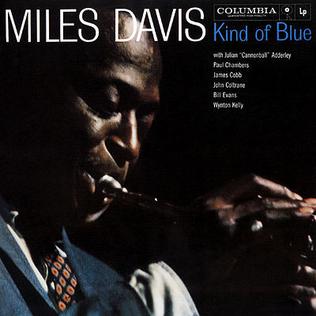
Kind of Blue is the fifth studio album released on Columbia, and twenty-eighth overall, by the American jazz musician, trumpeter, composer, and bandleader Miles Davis. It was recorded on March 2 and April 22, 1959, at Columbia's 30th Street Studio in New York City, and released on August 17 of that same year by Columbia Records. For the recording, Davis led a sextet featuring saxophonists John Coltrane and Julian "Cannonball" Adderley, pianist Bill Evans, bassist Paul Chambers, and drummer Jimmy Cobb, with new band pianist Wynton Kelly appearing on one track – "Freddie Freeloader" – in place of Evans.

Attilio Joseph "Teo" Macero was an American jazz saxophonist, composer, and record producer. He was a producer at Columbia Records for twenty years. Macero produced Miles Davis' Bitches Brew and Dave Brubeck's Time Out, two of the best-selling and most influential jazz albums of all time. Macero was known for his innovative use of editing and tape manipulation unprecedented in jazz and proving influential on subsequent fusion, experimental rock, electronica, post-punk, no wave, and acid jazz.

Filles de Kilimanjaro is a studio album by American jazz trumpeter Miles Davis. It was recorded in June and September 1968, and released on Columbia Records. It was released in the United Kingdom by the company's subsidiary Columbia (CBS) in 1968 and in the United States during February 1969. The album is a transitional work for Davis, who was shifting stylistically from acoustic recordings with his "second great quintet" to his electric period. Filles de Kilimanjaro was well received by contemporary music critics, who viewed it as a significant release in modern jazz. Pianist Chick Corea and bassist Dave Holland appear together on two tracks, their first participation on a Davis album.

Nefertiti is a studio album by jazz musician Miles Davis, released in March 1968. Recorded at Columbia's 30th Street Studio over four dates between June 7 and July 19, 1967, the album was Davis' last fully acoustic album. Davis himself did not contribute any compositions – three were written by tenor saxophonist Wayne Shorter, two by pianist Herbie Hancock, and one by drummer Tony Williams.

In a Silent Way is a studio album by American jazz trumpeter, composer, and bandleader Miles Davis, released on July 30, 1969, on Columbia Records. Produced by Teo Macero, the album was recorded in one session date on February 18, 1969, at CBS 30th Street Studio in New York City. Macero edited and arranged Davis's recordings from the session to produce the album. Marking the beginning of his "electric" period, In a Silent Way has been regarded by music writers as Davis's first fusion recording, following a stylistic shift toward the genre in his previous records and live performances.

Jack Johnson is a studio album and soundtrack by American jazz trumpeter, composer, and bandleader Miles Davis. It was released on February 24, 1971, by Columbia Records.
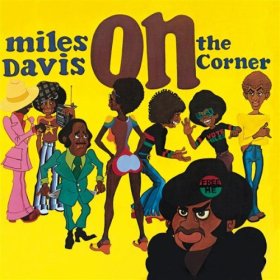
On the Corner is a studio album by American jazz trumpeter, bandleader, and composer Miles Davis. It was recorded in June and July 1972 and released on October 11 of the same year by Columbia Records. The album continued Davis's exploration of jazz fusion, and explicitly drew on the influence of funk musicians Sly Stone and James Brown, the experimental music of Karlheinz Stockhausen, the free jazz of Ornette Coleman, and the work of collaborator Paul Buckmaster.

Big Fun is an album by American jazz trumpeter Miles Davis. It was released by Columbia Records on April 19, 1974, and compiled recordings Davis had made in sessions between 1969 and 1972. It was advertised as a new album with "four new Miles Davis compositions" One of three Davis albums released in 1974 and largely ignored, it was reissued on August 1, 2000, by Columbia and Legacy Records with additional material, which led to a critical reevaluation.
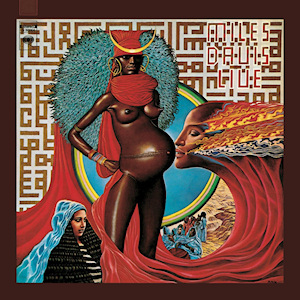
Live-Evil is an album of both live and studio recordings by American jazz musician Miles Davis. Parts of the album featured music from Davis' concert at the Cellar Door in 1970, which producer Teo Macero subsequently edited and pieced together in the studio. They were performed as lengthy, dense jams in the jazz-rock style, while the studio recordings consisted mostly of renditions of Hermeto Pascoal compositions. The album was originally released on November 17, 1971.

The Complete Bitches Brew Sessions is a four-disc box set by jazz trumpeter Miles Davis compiling recordings between August 19, 1969, and February 6, 1970—including the 1970 double album Bitches Brew in its entirety—and released on Columbia/Legacy on November 24, 1998.

Agharta is a 1975 live double album by American jazz trumpeter, composer, and bandleader Miles Davis. By the time he recorded the album, Davis was 48 years old and had alienated many in the jazz community while attracting younger rock audiences with his radical electric fusion music. After experimenting with different line-ups, he established a stable live band in 1973 and toured constantly for the next two years, despite physical pain from worsening health and emotional instability brought on by substance abuse. During a three-week tour of Japan in 1975, the trumpeter performed two concerts at the Festival Hall in Osaka on February 1; the afternoon show produced Agharta and the evening show was released as Pangaea the following year.

Pangaea is a live album by American jazz trumpeter, composer, and bandleader Miles Davis. It was originally released as a double album in 1976 by CBS/Sony in Japan.
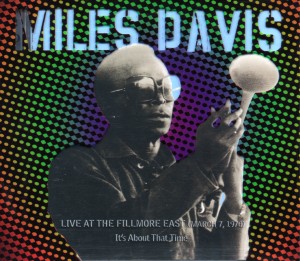
Live at the Fillmore East March 7, 1970: It's About That Time is a live double album by Miles Davis recording two sets performed on March 7, 1970 and released by Columbia/Legacy in 2001, although the concert had previously circulated as a bootleg recording.

Miles Davis at Fillmore is a 1970 live album by jazz trumpeter Miles Davis and band, recorded at the Fillmore East, New York City on four consecutive days, June 17 through June 20, 1970, originally released as a double vinyl LP. The performances featured the double keyboard set-up Davis toured with for a few months, with Keith Jarrett and Chick Corea playing electronic organ and Fender Rhodes electric piano, respectively. The group opened for Laura Nyro at these performances.

Black Beauty: Miles Davis at Fillmore West is a live double album by American jazz trumpeter, composer, and bandleader Miles Davis. It was recorded on April 10, 1970, at the Fillmore West in San Francisco, shortly after the release of the trumpeter's Bitches Brew album and the recording of Jack Johnson (1971). Black Beauty was produced by Teo Macero, Davis' longtime record producer. A jazz-rock and fusion album, Black Beauty captured one of Davis' first performances at a rock venue during the early stages of his electric period. At the concert, he led his band—saxophonist Steve Grossman, bassist Dave Holland, keyboardist Chick Corea, drummer Jack DeJohnette, and percussionist Airto Moreira—through one continuously performed set list which functioned as a musical suite for soloists to improvise throughout. He signaled changes from one piece to the next with phrases played on his trumpet.

Circle in the Round is a 1979 compilation album by jazz musician Miles Davis. It compiled outtakes from sessions across fifteen years of Davis's career that, with one exception, had been previously unreleased. All of its tracks have since been made available on album reissues and box sets.
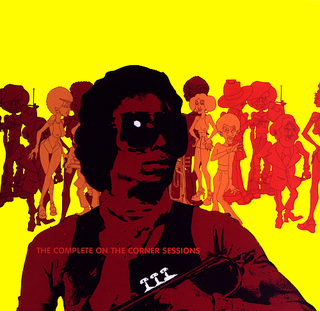
The Complete On the Corner Sessions is a posthumous box set by American jazz musician Miles Davis, released in the US on September 25, 2007, by Columbia Records and in the UK on September 29 on Legacy Recordings. Like other Davis box sets, the included material is taken from a wider chronology of sessions than the dates which actually produced the titular album. The Complete On the Corner Sessions compiles material from 1972 through 1975 which, due to lineup changes Davis made throughout the era, features over two dozen musicians.

Panthalassa: The Music of Miles Davis 1969–1974 is a remix album by Miles Davis, released on February 16, 1998, by Sony Records. It contains compositions from prior albums, including In a Silent Way (1969), On the Corner (1972), and Get Up With It (1974), remixed by Bill Laswell; it is subtitled "Reconstruction and Mix Translation by Bill Laswell". The album was composed as a dark, continuous tone poem divided by four sections of Davis' jazz fusion recordings. Panthalassa received generally positive reviews from music critics and sold well, charting at number four on the Billboard Top Jazz Albums.

Bitches Brew Live is a live album by Miles Davis. The album was released in February 2011 and contains material compiled from two concert performances. Most of the songs on the album originally appeared on Bitches Brew. The first three tracks were recorded at the Newport Jazz Festival in July 1969, nine months before the release of Bitches Brew, while the rest of the album was recorded at 1970 Isle of Wight Festival. The three cuts from Newport—"Miles Runs the Voodoo Down", "Sanctuary", and "It's About That Time/The Theme"—were previously unreleased at the time and have since been reissued on Miles Davis at Newport 1955–1975: The Bootleg Series Vol. 4. This recording marks the first known time that "Miles Runs the Voodoo Down" was professionally recorded. The final six cuts appeared on the "Miles Electric" DVD in video form and the audio portion was included in the box set Miles Davis: The Complete Columbia Album Collection. A seventeen-minute segment appeared under the title "Call It Anything" on the First Great Rock Festivals of the Seventies: Isle of Wight/Atlanta Pop Festival compilation album in 1971.
